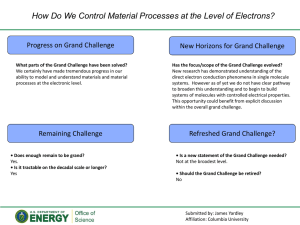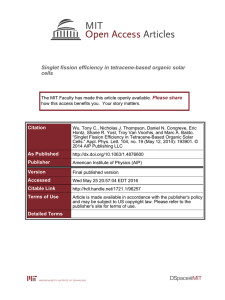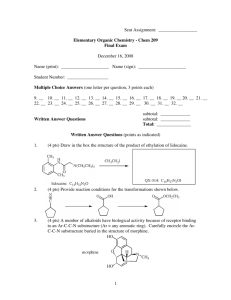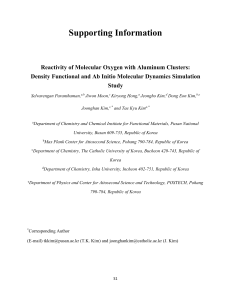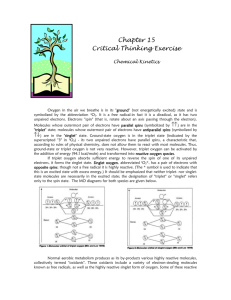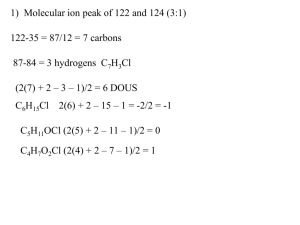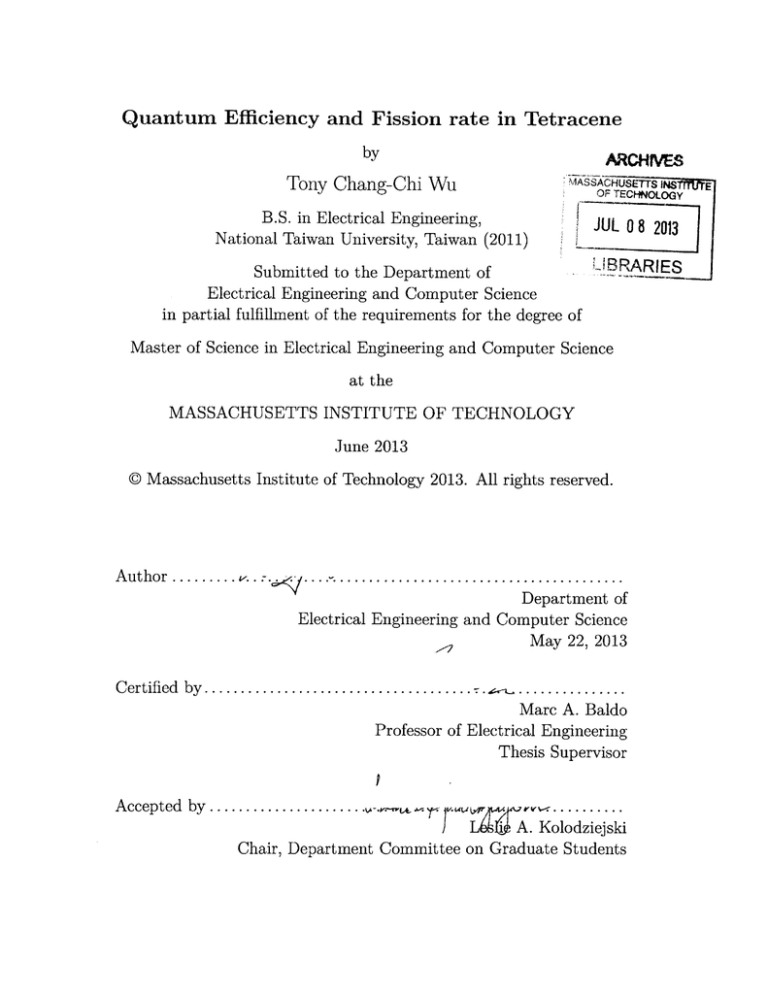
Quantum Efficiency and Fission rate in Tetracene
by
ASCHES
Tony Chang-Chi Wu
6H5XNUSETS INS VE
OF TECHNOLOGY
B.S. in Electrical Engineering,
National Taiwan University, Taiwan (2011)
JUL 0 8 2013
Submitted to the Department of
Electrical Engineering and Computer Science
in partial fulfillment of the requirements for the degree of
IBRARIES
Master of Science in Electrical Engineering and Computer Science
at the
MASSACHUSETTS INSTITUTE OF TECHNOLOGY
June 2013
@ Massachusetts Institute of Technology 2013. All rights reserved.
A uthor .........
....
.......................................
Department of
Electrical Engineering and Computer Science
May 22, 2013
Certified by....................................
.......
Marc A. Baldo
Professor of Electrical Engineering
Thesis Supervisor
Accepted by......................
.
r
V.(4.:..
t
.
Gra
;m
..
Kolodziejski
Chair, Department Committee on Graduate Students
2
Quantum Efficiency and Fission rate in Tetracene
by
Tony Chang-Chi Wu
Submitted to the Department of
Electrical Engineering and Computer Science
on May 22, 2013, in partial fulfillment of the
requirements for the degree of
Master of Science in Electrical Engineering and Computer Science
Abstract
Using singlet fission in a photovoltaic cell, the theoretical energy conversion efficiency limit is larger than the Shockley-Queisser limit due to two excitons produced
with one incident photon. In a singlet fission material, an absorbed photon excites a
singlet exciton and then split into two triplet excitons with energy around half of the
singlet exciton. Tetracene is a potential candidate for singlet fission photovoltaic cells.
Tetracene has triplet exciton energy around 1.2 electron volts (eV), which matches
with silicon band gap (1.1 eV). In this study, the quantum efficiency of tetracene
devices are measured. Secondly, we will build a kinetic model to calculate the triplet
yield rate from magnetic field effect. By modeling and experimental data, we will
show that tetracene is an efficient fission material.
Thesis Supervisor: Marc A. Baldo
Title: Professor of Electrical Engineering
3
4
Acknowledgments
My first gratitude goes to my advisor, Dr. Marc Baldo, whose enthusiasm and scientific insights have led me into the world of organic semiconductor. His knowledge
and experiences in organics had helped me overcome several key situations during
research.
I would like to thank our Soft Semiconductor group members for the supports.
Nick Thompson, Dan Congreve and Matthias Bahlke helped me many times with the
deposition chamber and measurement setup. Carlijn Mulder for teaching me how to
grow crystals with many secret tips. Jiye Lee always give me insightful suggestions
on my experiments. Priya Jadhav taught me many things about tetracene.
Finally, I would like to thank the support of the Center for Excitonics, an Energy
Frontier Research Center funded by the U.S. Department of Energy, Office of Science,
Office of Basic Energy Sciences.
5
6
Contents
1
Introduction
13
2
Singlet Fission
17
3
4
5
2.1
Simple Mechanism of Singlet Fission
. . . . . . . . . . . . . . . . . .
17
2.2
Theory of Magnetic Field Effect . . . . . . . . . . . . . . . . . . . . .
19
Quantum Efficiency of Tetracene Devices
21
3.1
Fabrication and Experimental Methods . . . . . . . . . . . . . . . . .
21
3.2
Results and Discussion . . . . . . . . . . . . . . . . . . . . . . . . . .
24
27
Magnetic Field Effect
4.1
Diffusion Modeling . . . . . . . . . . . . . . . . . . . . . . . . . . . .
27
4.2
Experimental Methods and Setup . . . . . . . . . . . . . . . . . . . .
29
4.3
Results and Discussion . . . . . . . . . . . . . . . . . . . . . . . . . .
31
37
Conclusion
7
8
List of Figures
1-1
Shockley-Queisser Limit . . . . . . . . . . . . . . . . . . . . . . . . .
14
1-2
High Efficiency Singlet Fission Solar Cell . . . . . . . . . . . . . . . .
15
2-1
Singlet Fission . . . . . . . . . . . . . . . . . . . . . . . . . . . . . . .
18
2-2
Singlet Fission Transport Mechanism . . . . . . . . . . . . . . . . . .
19
2-3
Magnetic Field Effect . . . . . . . . . . . . . . . . . . . . . . . . . . .
20
3-1
Tetracene Device Structures . . . . . . . . . . . . . . . . . . . . . . .
22
3-2
EQE Measurement Setup . . . . . . . . . . . . . . . . . . . . . . . . .
23
3-3
Maximum EQE Photovoltaic Cell . . . . . . . . . . . . . . . . . . . .
24
3-4
Peak EQE versus Tetracene Thicknesses
. . . . . . . . . . . . . . . .
25
4-1
Kinetic Model of Magnetic Field Effect . . . . . . . . . . . . . . . . .
28
4-2
Magnetic Field Effect Setup
. . . . . . . . . . . . . . . . . . . . . . .
30
4-3
Photocurrent Change Dependence on Magnetic Field Strength . . . .
31
4-4
Fluorescence Change Dependence on Magnetic Field Strength
. . . .
32
4-5
Photocurrent Change versus Tetracene Thicknesses
. . . . . . . . . .
33
4-6
Fluorescence Change versus Tetracene Thicknesses . . . . . . . . . . .
34
4-7
Triplet Exciton Yield . . . . . . . . . . . . . . . . . . . . . . . . . . .
35
9
10
List of Tables
1.1
Tandem Solar Cells Optimal Efficiency
. . . . . . . . . . . . . . . . .
14
2.1
Exciton Energies of Fission Materials . . . . . . . . . . . . . . . . . .
18
3.1
Energy Levels of Organics in Tetracene Device . . . . . . . . . . . . .
22
11
12
Chapter 1
Introduction
Solar power is a promising, clean and sustainable energy. To provide the potential
of using solar power: 1.16 hours of solar energy absorbed by the earth is sufficient
to sustain the total human-used energy throughout 2009 [1]. An important element
of harvesting the solar energy is the efficiency of solar cells. However, according to
the Shockley-Queisser limit [13], a single p-n junction solar cell has the theoretical
maximum solar conversion efficiency of 33.7%. This conversion efficiency limitation
is due to two main loss mechanisms: the loss of photons with energy lower than the
solar cell band gap, and the loss of energy relaxation due to the generated carriers
that have energies larger than the band gap. Calculating from the solar spectrum,
the maximum efficiency for a single p-n junction solar cell is 33.7% for a band gap
of 1.34 eV [13], as shown in figure
1-1. A double junction solar cell can overcome
the conversion limit by collecting the higher energy photon with wider band gap and
lower energy photon with smaller band gap. The maximum conversion efficiency for
a double junction solar cell is 42% with bandgaps of 1.9 eV and 1.0 eV [15]. Table
1.1 is a list of efficiency for multiple junction solar cells.
An alternative method to overcome the Shockley-Queisser limit is to decrease
the loss of relaxation by generating more than one carrier from higher energy photons [14] [9]. Take a fission single junction solar cell with band gap Eg for example:
if the photovoltaic cells could generate 2 electrons for photon energy above 2Eg, then
13
n
r/(%)
Bandgaps(eV)
1
2
3
4
30
42
49
53
1.3
1.9, 1.0
2.3, 1.4, 0.8
2.6, 1.8, 1.2, 0.8
Table 1.1: Optimal sets of bandgaps and conversion efficiency for tandem solar
cells. [15]
30
C20
X
C0
2
0
0-
0
1
2
Bandgap (eV)
Figure 1-1: The figure shows the relation between maximum conversion efficiency and
the band gap of p-n junction solar cells. The figure are from wiki which is calculated
according to Shockley and Queisser works [13].
the fission solar cell produces more energy than a normal one. This method simulates
a double junction solar cell with bandgaps 2Eg and Eg [14].
Multiple exciton generation (MEG) [2] and singlet fission [11] [8] are studied phenomenon that could create multiple lower energy excitons from a single photon. MEG
happens mostly in synthesized nanocrystals and carban nanotubes. However, it is
hard to harvest the energy from the multiexcitons with short lifetimes. Singlet fission
is an efficient process that a singlet exciton splits into two triplet excitons with approximately half the singlet exciton energies [14] [11] [8] [4]. Currently, near 200% triplet
exciton yield are found [5]. Singlet fission is found in limited organic semiconductor
materials that are mostly acenes [14]. By adding a fission material with a matching
14
Singlet
Fission
Fission
Material
Low
Bandgap
Material
Figure 1-2: The figure shows the structure of a theoretical high efficiency solar cell
in aid of singlet fission. The solar cell is collecting multiple charges at high energy
photons by singlet fission. [9]
lower band gap material, the theoretical efficiency limit exceeds the Shockley-Queisser
limit. The proposed structure of this solar cell is shown in figure 1-2 [9].
An interesting and promising fission material is tetracene [14] [7] [8] [3]. Tetracene
has several advantages as a fission material. First of all, tetracene has been studied
and observed with singlet fission [11] [8]. Furthermore, the triplet exciton energy is
around 1.2 electron volts (eV) [9], which is slightly higher than the well-studied silicon
band gap (1.1 eV). This would be great as a candidate to match with silicon for a
higher efficiency solar cell. However, there are different reports on tetracene fission
efficiency.
In this thesis, we will first show the external quantum efficiency of tetracene
devices. It is an important indication of overall singlet fission and device performance.
Secondly, we will demonstrate a method to determine the tetracene singlet fission
rate from the magnetic field effect of singlet fission and diffusion modeling. Both
experiments will be measured on tetracene solar cell and photodetectors and the
structures are further discussed in chapter 3.1.
15
16
Chapter 2
Singlet Fission
2.1
Simple Mechanism of Singlet Fission
Singlet fission is a singlet exciton splits that into two triplet excitons. The process
has been found efficiently in several organic materials. The efficient singlet fission is
due to a combination of 1) long Frenkel exciton lifetimes, 2) energy favored transition
with singlet energy equals or larger than two triplet energies and 3) close stacking
between organic molecules. Recently, near 200% singlet fission yield has been demonstrated [5].
The simple mechanism of singlet fission is shown in figure
fission material first absorbs photon and creates a singlet state S1.
2-1.
The
The Si state
lives long enough that splits into two triplet states with each approximately half the
energy of Si [14].
The triplet states will then diffuse to and be separated at the
donor/acceptor interface or other recombination process. Currently, efficient fission
process are found in organic materials such as tetracene and pentacene [14] [4]. In
addition, triplet-triplet (T-T) annihilation are shown in some of these materials and
also anthracene [10] [6] [8]. The T-T annihilation is a reverse process that two triplets
fuse into a singlet exciton. Table 2.1 is a list of singlet and triplet state energies for
common fission molecules [14].
There are other more fission material observed but
with less fission rates.
Figure 2-2 shows a simple singlet fission based photovoltaic cell (PV) with tetracene
as the fission material. Similar to section 2.1, tetracene absorbs a photon and cre-
17
Compound
E(S1 )
E(T)
Anthracene
Tetracene
Pentacene
3.13
2.32
1.83
1.83
1.25
0.81
Table 2.1: List of singlet and triplet state energies for several fission materials. The
energy unit is electron volts (eV). [14]
S1
Singlet
Fission
Photons
$0'2*T
so
so
Figure 2-1: The figure is a simple mechanism of singlet fission process. The Si singlet
state is first populated by photons or other methods. The Si state undergoes a singlet
fission process and splits into two triplet states.
ates a singlet exciton that splits into to triplet excitons [9]. Different to traditional
semiconductor solar cells, organic PVs cannot dissociate the excitons with an internal
electric field or depletion region. Instead, the triplet excitons are diffused through
the organic crystals to the donor-acceptor interface and separated into charge transfer states, which are bounded electron hole pairs across the interface [5]. The charge
transfer state are then dissociated into free carriers and collected as photocurrent.
18
(b)
Donor (Tetracene)
Acceptor
(c)
(d)
Figure 2-2: (a) Tetracene absorbs a photon and creates a singlet exciton. (b) The
singlet exciton splits into two triplet excitons. (c) Triplet exciton diffuses and creates
a charge transfer state at the donor/acceptor interface. (d) The excitons are separated
into electrons and holes.
2.2
Theory of Magnetic Field Effect
Singlet fission rate depends on magnetic fields and the effects are clearly shown in
many fission or T-T annihilation materials [11] [6]. There are theoretical studies on
calculating the dependence of fission rate and magnetic fields [6] [10] [12]. For singlet
excitons to split into two triplet excitons, the spin must conserve during transition
under selection rule [10] [12]. Figure 2-3 shows that the transition relation between
singlet exciton states, two triplets (TT) pair states and separated triplet exciton
states. The transition rate are modified by
of TT pair states as shown in figure
IS, 12,
the fraction of singlet spin character
2-3. The singlet spin component of the TT
pair states can be calculated by Hamiltonian. The pair spin Hamiltonian of the two
triplets (TT) pair is:
7W = g#H x (S1 + S2 ) + D(S
1
+ Sz2 ) + E(Sx 1 ±+ S 2 - S21
19
-
S 2)
(2.1)
k1k2
S1
k-2
k-i_______
Singlet
T+T
*
TT Pair States
Triplet
Figure 2-3: This figure describes the transition between singlets, TT pair states
and triplets. According to selection rules, only the TT pair states with singlet spin
character are allowed for transition between TT and singlets. The |Sil2 denotes the
fraction of singlet spin character of TT pair state ij [12].
The first term is the Zeeman interaction from magnetic field H and the rest are fine
structure splitting by the organic molecules. The fission rate could be calculated by
pair density matrix numerically [10].
As a simple scheme, in zero magnetic fields, there are three triplet pair states with
singlet components. In high magnetic fields, there are only two states with singlet
spin components, shown in the following equations. As a qualitative description, the
fission rate is smaller in high magnetic fields as the singlet spin character TT pair
states are less. The less TT pair states will cause the decrease of the singlet transfer
rate [10] [12].
10 > = 10,0 >
(2.2)
11 > = v/2(|+ 1, -1 > +1 - 1, +1 >)
(2.3)
20
Chapter 3
Quantum Efficiency of Tetracene
Devices
It is very important for solar cells and photodetectors to determine the efficiency
of how the photocurrent are collected. The external quantum efficiency (EQE) of
the device represents the percentage of photocurrent generated from incident photons. The EQE indicates the total performance of solar cells and photodetectors,
including all absorption, exciton diffusion, charge separation and transportation. We
will be showing EQE with different tetracene thicknesses in photovoltaic cells and
photodetectors.
3.1
Fabrication and Experimental Methods
The tetracene photovoltaic cells and photodetectors structures are shown in figure
3-1 [9]. The substrates are pre-deposited with ITO. We first clean the samples with
detergent, Acetone, Isopropanol and oxygen plasma. PSS:PEDOT layer is then spun
on the cleaned substrates. Then deposit tetracene, C60, BCP, and aluminum or silver
on the substrates in the Angstrom Deposition Chamber.
Finally, we package the
devices with epoxy and glass substrates to prevent oxidization during measurements.
We made photovoltaic cells with tetracene thicker than 10nm and photodetectors for
21
(b)
(a)
Tetr
PE
P
ace
ne
n
A
C60
BCP
ITO
Tetr
Tetr .
ace
ne
en
ace
ne
PEDC
TPS
C60
C60
BCP
TPSSE
Figure 3-1: (a) Tetracene Photovoltaic Cell, (b)Tetracene Photodetectors.
thickness less than 10nm. We made photodetectors for thinner devices to collect and
generate enough photocurrent for reliable signals.
For this device structure, the ITO and metal contacts are the anodes and cathodes. The PEDOT layer is important as it creates a flat surface to prevent the devices
from shorting after deposition. Tetracene and C60 are the organic donors and acceptors. Excitons created in tetracene and C60 are separated at the donor-acceptor
interface. BCP layer is an exciton blocking layer that also serves as preventing metal
penetrations. Table 3.1 is a list of the highest occupied molecular orbitals (HOMO)
and lowest unoccupied molecular orbitals (LUMO) of organic molecules used in the
tetracene photovoltaic cells and photodetectors [9] [5].
Organics
1
2
3
HOMO(eV)
5.4
6.6
7.0
LUMO(eV)
2.4
4.5
3.5
Table 3.1: Table of HOMO and LUMO of organic molecules used in our tetracene
photovoltaic cells and photodetectors.
To measure the EQE with different wavelengths, we use the light source from a
xenon lamp and a monochromator. We first measure the incident photons Io(A) with
a photodetector of the same area size as our device. Then measure the photocurrent
22
Monochromator
Xenon
Lamp
Chopper
Device or
Photodetector
Figure 3-2: The figure is a setup for measuring the EQE of tetracene photovoltaic
cells and photodetectors. The monochromator selects a specific wavelength of light
from xenon lamp.
It(A) from the device. The measurement was done with a chopper and a SR830
Lock In Amplifier for better signals. The EQE is then obtained by dividing the
photocurrent to the incident photons. Figure 3-2 is a diagram of the setup.
EQE(A)
23
-
It(A)
I0(A)
(3.1)
EQE (1210082)
30
20-
10
300
350
400
450
50
550
600
650
700
Wavelength [nm]
Figure 3-3: Tetracene/C60/BCP/Aluminum = 90nm/30nm/7nm/1000nm.
3.2
Results and Discussion
We investigate different thicknesses of tetracene layer. Figure 3-3 is the maximum
EQE tetracene photovoltaic cell in the set of devices. It has 59% EQE at wavelength
475nm and 56% at 508nm. The device has a 90nm tetracene layer and 30nm of C60.
Figure 3-4 plots the peak EQE of each tetracene devices with tetracene thicknesses. The peak EQE are maximum EQE of each device around wavelength 500nm550nm. The thicknesses are the maximum exciton traveling distance to the donoracceptor interface, which is equals the tetracene thickness for a photovoltaic cell but
half the thickness for photodetectors. We could see that the maximum peak EQE
is at 90nm photovoltaic cell with 56%. The maximum peak EQE occurs due to the
competition between two mechanism involved with the tetracene thickness [5]. The
first one is the loss process due to recombination during diffusion. The longer diffusion length allows a higher chance to recombine and lose the excitons created. The
second one is an increasing relation with more absorption and fission as the tetracene
thicknesses increase. The longer diffusion length will allow the singlet excitons to
24
60
0m
e
aU
Iw
203
0
50
100
150
200
Greatest Distance [nm]
Figure 3-4: Maximum Peak EQE of 56% at tetracene 90nm photovoltaic cell.
split into two triplets before reaching the surface. The competing processes result in
a maximum peak EQE at tetracene 90nm photovoltaic cell.
25
26
Chapter 4
Magnetic Field Effect
Diffusion Modeling
4.1
Figure 4-1 is a simple kinetic model of magnetic field effect [5] [10]. It can explain
the relation of both photocurrent and fluorescence change to tetracene thickness.
The photocurrent and fluorescence under this model is,
1= 10
F
F0
kC
kd
2 x k
_+
kks
kcs + ks + k5 + kt
kcs + ks + k5 + k, ka + kTT kcT + kT
(4.1)
(4.2)
k
kcs + ks + k5 + k,
The first term of equation 4.1 represents the photocurrent from singlet excitons
and the second term is from triolet excitons.
For simplification, we assume that
non-radiation recombination rates are negligible, which means ks, kTT, kT are approximately 0. The photocurrent and fluorescence are simplified as,
I = Io
kcs
+
(kcs + k5 + ky
F=F0 (
k)
kFs + ke+t k
2
x
kf
kcs + k5 + k,
)
(4.3)
(4.4)
For calculation ease, we simplify the equations with dimensionless variables based
27
hv
kv
kcs
kf
kd
b
S,1
TT
kTT
ks
so
kCT
b T+T
So
-
e
Kt
so
Figure 4-1: kcS and kcT charge separation rate are dependent on distance relation.
kg fission rate is dependent only on magnetic field according to section 2.2. ks, kTT,
kT are non-radiation recombination rates. k, is the singlet radiation decay. kd is the
dissociation rate of TT pair state.
28
on kf (H = 0) = k1 o. We substitute equations 4.3 and 4.4 with k 1 (H) = kfo x Xi(H),
kcs = k1 o x Xcs and k, = kfo x X7. Then the equations become,
I(H) = 10
F(H) = FO
(XcS
+ 2X5(H)
(4.5)
xH)
(4.6)
\xcs + x5 (H ) + xy)
\xcs + x5 (H ) + xy)
With Xf(0) = Xfo = 1 and Xf(Hhigh)
Xfh, the photocurrent change under high
=
magnetic field is,
(xfh - Xfo) (Xcs +
71 = I(Hhigh) - 1(0)
2
Xy)
(xcs + Xfh + x,) (Xcs ± 2 Xf0)
1(0)
Similarly, the fluorescence change under high magnetic field is,
F(Hhigh) - F(O)
F(0)
From these equations
4.7 and
X5O - Xfh
Xcs + Xfih ± X
(4.8)
4.8, we could determine the parameters from
measured relation between photocurrent/fluorescence change and tetracene thickness.
We could also calculate the triplet yield from the variables.
TY =
4.2
2 x kro
kcs + kfO + ky
(4.9)
Experimental Methods and Setup
Figure 4-2 is the magnetic field effect setup for measuring the photocurrent and
fluorescence change under magnetic field.
The strong electromagnet is controlled
through program to apply a changing magnetic field on the device. The photocurrent
change is measured under 530nm of incident light with a chopper and a lock in amplifier. For the fluorescence, we measured it under 470nm of excitation light and filter
29
Strong
Electromagnet
Device or
, Sample
Chopper
LED
Photocurrent or
Fluorescence
Signal
SR830 Lock In
Amplifier
Figure 4-2: The figure is a magnetic field effect setup for measuring the photocurrent
and fluorescence change under magnetic field. We use 530nm LED for photocurrent
measurement and 470nm LED for fluorescence. The output signal is either measured
directly or by photodetectors.
30
Magnetic Field Effect (1210681C3)
~.C
Magnetic Field [T]
Figure 4-3: The figure is the relation between photocurrent change and applied magnetic field. This is a photovoltaic cell structure with Tetracene/C 60/BC P/Aluminum
= 30nm/30nm/7nm/1000nm.
out fluorescence with wavelength larger than 500nm. The samples for fluorescence
measurement are the exact same structure to the photovoltaic cell devices but with
larger area for stronger fluorescence signal.
4.3
Results and Discussion
Figure
4-3 and figure
4-3 are the photocurrent and fluorescence change with
varied magnetic field [5] [8]. The photovoltaic cell has 30nm of tetracene. We could
see that the overall trend of the fluorescence change with magnetic field is opposite of
photocurrent change. It is qualitatively correct as section 2.2 implies that a strong
magnetic field will lower the rate of creating triplets, thus causing the photocurrent
in figure 4-3 decreases in strong magnetic field. On the other hand, the less triplet
created means more singlet exetons in the tetracene, therefore the figure 4-4(b) has
an increase of fluorescence at strong magnetic field. The bump in the low field is a
calculation result from equation 2.2. At certain weak magnetic field values, there are
six triplet pair states with singlet components.
Figure 4-5 is the photocurrent change of different tetracene thickness device. The
31
Magnetic Field Effect (121008114)
14
10 0
0
0
02
0.0
j01
0.15
0.2
0.25
0.3
36
0.4
0.45
0.5
Magnetic Fied M1
Figure 4-4: The figure is the relation between fluorescence change and applied magnetic field. This is a photovoltaic cell structure with Tetracene/C 60/B CP/Aluminum
= 30nm/3Onm/7nm/1000nm.
photocurrent change are measured under strong magnetic field. We could see that the
largest photocurrent change (most negative) occurs at 30nm of tetracene thickness,
with change -2.71%. The physical picture of this relation is similar to section 3.2.
A bigger photocurrent change corresponds to a higher singlet fission rate. Therefore,
longer diffusion length will create more triplet excitons, but will lose more excitons
due to recombination.
By using the equation
4.7, we could calculate the dimensionless variables with
extreme Xcs values. Two important points are at large tetracene thickness and maximum photocurrent change. Calculating numerically, we could get
Xfh = 0.86
(4.10)
XY = 0.06
(4.11)
Xfh represents the fission rate change under strong magnetic field. A change of -15%
is consistent with what was found in other materials. There is also around 6% of
fluorescence rate in compare with singlet fission rate kfo.
Figure 4-6 is the fluorescence change of different tetracene thickness device. The
32
Magnetic Field Effect
7
.
-.
5
-2.5
0
20
40
60
0
100
120
140
16
180
200
Distance [nm]
Figure 4-5: The curve is the relation between tetracene thicknesses and photocurrent
change of each devices under high magnetic field (H > O.4T). The largest photocurrent change (most negative) occurs at 30nm of tetracene thickness, with change
-2.71%.
33
dFIF vs Distance
20
18
16 -
14 U.
O-
VO
12 --0
M
CM10
--
U. 0
41
0
20
40
60
80
100
120
140
160
180
200
Greatest Distance [nm]
Figure 4-6: The curve is the relation between tetracene thicknesses and fluorescence
change of each devices under high magnetic field (H > O.4T). The fluorescence change
increases monotonically as tetracene thickness increase, saturating with a fluorescence
change 19.35%.
fluorescence change are measured under strong magnetic field. We could see that
different to figure 4-5, the fluorescence change are monotonically increase with respect
of thicker tetracene. It is qualitatively correct according to equation 4.8.
From the calculated variables 4.10 and 4.11, we could estimate the triplet exciton
yield with different thickness. From figure 4-7, we see that triplet exciton yield are
near 190% at thick tetracene devices. This means that after long distance of diffusion,
most singlets are converted to triplets, achieving near 200% triplet exciton yield. It
indicates that fission process is quite efficient in tetracene.
34
4D.
08--
0.6
0
0.4
0.2
0
20
40
60
80
100
120
140
160
10
200
distances (nm)
Figure 4-7: The figure shows a near 200% triplet exciton yield.
35
36
Chapter 5
Conclusion
Understanding the singlet fission efficiency and mechanism in tetracene is important for future studies.
From section
3.2 figure
3-4, we demonstrate an external
quantum efficiency of 56% in tetracene photovoltaic cells. By the relations between
photocurrent/fluorescence change and tetracene thickness, the triplet yield rate is
calculated around 190% in thick tetracene layer. From these results, we show that
tetracene has high singlet fission rate.
Although, the EQE did not exceed 100%,
tetracene is still a potential fission material for future studies.
37
38
Bibliography
[1] Us energy information administration.
http://www.eia.gov/.
[2] M. C. Beard and A. J. Nozik et al. Multiple exciton generation in colloidal silicon
nanocrystals. Nano Lett., 7(8), 2007.
[3] J. J. Burdett and C. J. Bardeen et al. Excited state dynamics in solid and
monomeric tetracene: The roles of superradiance and exciton fission. J. Chem.
Phys, 133(14), 2010.
[4] W. L. Chan and X.-Y. Zhu et al. Observing the multiexciton state in singlet
fission and ensuing ultrafast multielectron transfer. 334, 2011.
[5] D. N. Congreve, J. Lee, N. J. Thompson, and M. A. Baldo et al. External quantum efficiency above 100% in a singlet-exciton-fission-based organic photovoltaic
cell. 330, 2013.
[6] V. Ern and R. E. Merrifield. Magnetic field effect on triplet exciton quenching
in organic crystals. Phys. Rev. Lett., 21(9), 1968.
[7] N. Geacintov, M. Pope, and F. Vogel. Effect of magnetic field on the fluorescence
of tetracene crystals: Exciton fission. Phys. Rev. Lett., 22(12), 1969.
[8] R. P. Groff, P. Avakian, and R. E. Merrifield. Coexistence of exciton fission and
fusion in tetracene crystals. Physical Review B, 1(2), 1970.
[9] P. J. Jadhav and M. A. Baldo et al. Singlet exciton fission in nanostructured
organic solar cells. Nano Lett., 11(4), 2011.
[10] R. C. Johnson and R. E. Merrifield. Effects of magnetic fields on the mutual
annihilation of triplet excitons in anthracene crystals. Physical Review B, 1(2),
1970.
[11] R.E. Merrifield, P. Avakian, and R.P. Groff. Fission of singlet excitons into pairs
of triplet excitons in tetracene crystals. Chemical Physics Letters, 3(6), 1969.
[12] Martin Pope and Charles E. Swenberg. Electron Processes in Organic Crystals
and Polymers. McGraw Hill, 1999.
39
[13] W. Shockley and H. J. Queisser. Detailed balance limit of efficiency of p-n
junction solar cells. Journal of Applied Physics, 32(510), 1961.
[14] M. B. Smith and J. Michl. Singlet fission. Chem. Rev., 110(11), 2010.
[15] A. D. Vos. Detailed balance limit of the efficiency of tandem solar cells. J. Phys.
D, 13(5), 1980.
40

